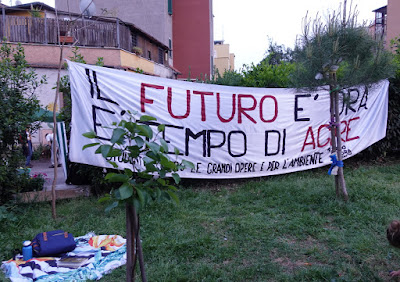 |
| "Liberation...April 25...Pigneto Neighborhood Party" |
For non-Italians and others who many not recall, April 25 is Liberation Day in Rome, a date - in 1945 - selected by the state to celebrate the liberation of Italy from the Germans. Rome was liberated earlier, June 4, 1944, as the Allies moved up from the South, driving the Germans north.
 |
| "In the social fight, LIBERATION!" (One can see why Salvini might not have liked this.) |
That contestation continued this year, when the Deputy PM and leader of the right-wing, anti-immigrant party the Lega, Matteo Salvini, declared he would not show up at any Liberation Day events, because, as he said, "On April 25 there will be parades, partisans, anti-partisans, fascists, communists, reds, blacks, and greens, blues, yellows, reds. We are in 2019, I am not interested in the fascist-communist derby...." (He chose instead to go to Corleone, a Mafia-infested town in Sicily to show (off) that his government was combating the Mafia.)
Comparing the liberation of Italy from the Nazis to a soccer game - a "derby" is a soccer tournament that pits the two biggest rivals against each other - is trivializing it, to say the least. Very clear echoes of "there are fine people on both sides." (For a discussion of the right-wing brazenness and the dangers of indifference, see Roger Cohen's op ed in the NYT.)
| A very short 2 blocks from our door we found, instead of the usual sleepy enoteca (think 'wine bar') with 1 or 2 customers, this crowd, live music, lots of emptied wine and beer bottles. |
This year the turnout on the left seemed especially high, and, the Jews and the partisan organization (ANPI - Associazione Nazionale Partigiani d'Italia) marched together. They had not in the recent past because (as I recall) of ANPI's support for Palestine.
(For more on Liberation Day, see Frederika Randall's excellent post on the partisan anthem, "Bella Ciao.")
Almost all our friends in Rome participated in the day in some way. One took his granddaughter to lay flowers at the Fosse Ardeatine, the caves where more than 300 Italian men were summarily executed by the Nazis in retaliation for a partisan bombing that killed 33 German soldiers in March 1944. (Here is a post on the Fosse Ardeatine, which is also in an itinerary in our book.)
 |
| "The future is now; it's time to act" (and something about "big projects for the environment") - slogan and picnic. |
Leave it to the Left to be intensely political and also to enjoy themselves. The neighborhood we chose to live in this year is without doubt a leftist one. Bill is collecting slogans and posters and will post them at some point. I've included a few here that were put up for the street celebration.
 |
| Posters advertising the party; graffiti protesting gentrification. The red flag in the distance is an ANPI flag. |
 |
| A prize ceremony, showing the ethnically-mixed neighborhood. Not sure what the prizes were for. The "prize" was a red ANPI neck scarf. |
Dianne
 |
| Again, a street near us, usually quiet, now spilling over with customers, and, yes, it's a car-driving street. |
 |
| There were games - foosball, ping pong - babies, dogs, you name it. |
 |
| Basically a message to the governments of Rome and Lazio (the province in which Rome sits): "Over our territory, we will decide!" |












